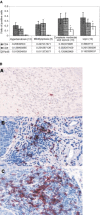Increase in immune cell infiltration with progression of oral epithelium from hyperkeratosis to dysplasia and carcinoma
- PMID: 11986779
- PMCID: PMC2375378
- DOI: 10.1038/sj.bjc.6600282
Increase in immune cell infiltration with progression of oral epithelium from hyperkeratosis to dysplasia and carcinoma
Abstract
In the present study, epithelium derived lesions of various pathological manifestations were examined histologically and immunohistochemically for mononuclear cell infiltration. The infiltrate under the transformed epithelium of oral lesions, was examined for differences in the composition of immune mononuclear cells as the epithelium moves from hyperkeratosis through various degrees of dysplasia to squamous cell carcinoma. The study was performed on 53 human tongue tissues diagnosed as hyperkeratosis (11 cases), mild dysplasia (nine cases), moderate and severe dysplasia (14 cases) and squamous cell carcinoma (19 cases). A similar analysis was performed on 30 parotid gland tissues diagnosed as pleomorphic adenoma (14 cases) and carcinoma ex-pleomorphic adenoma (16 cases). Immunohistochemical analysis of various surface markers of the tumour infiltrating immune cells was performed and correlated with the transformation level as defined by morphology and the expression of p53 in the epithelium. The results revealed that, in the tongue lesions, the changes in the epithelium from normal appearance to transformed were accompanied by a corresponding increase in the infiltration of CD4, CD8, CD14, CD19+20, and HLA/DR positive cells. The most significant change was an increase in B lymphocytes in tongue lesions, that was in accordance with the transformation level (P<0.001). In the salivary gland, a significant number of cases did not show an infiltrate. In cases where an infiltrate was present, a similar pattern was observed and the more malignant tissues exhibited a higher degree of immune cell infiltration.
Copyright 2002 Cancer Research UK
Figures






References
-
- AuclairPLEllisGL1996Atypical features in salivary gland mixed tumors: their relationship to malignant transformation Mod Pathol 9652657 - PubMed
-
- BarreraJLVerasteguiEMenesesAZinserJde la GarzaJHaddenJW2000Combination immunotherapy of squamous cell carcinoma of the head and neck: a phase 2 trial Arch Otolaryngol Head Neck Surg 126345351 - PubMed
-
- EllisGLAuclairPL1996Benign Epithelial NeoplasmsInTumors of the salivary glandspp468Washington, DC: Armed Forces Institute of Pathology
-
- HirotaJUetaEOsakiTOgawaY1990Immunohistologic study of mononuclear cell infiltrates in oral squamous cell carcinoma Head Neck 12118125 - PubMed
Publication types
MeSH terms
LinkOut - more resources
Full Text Sources
Medical
Research Materials
Miscellaneous

